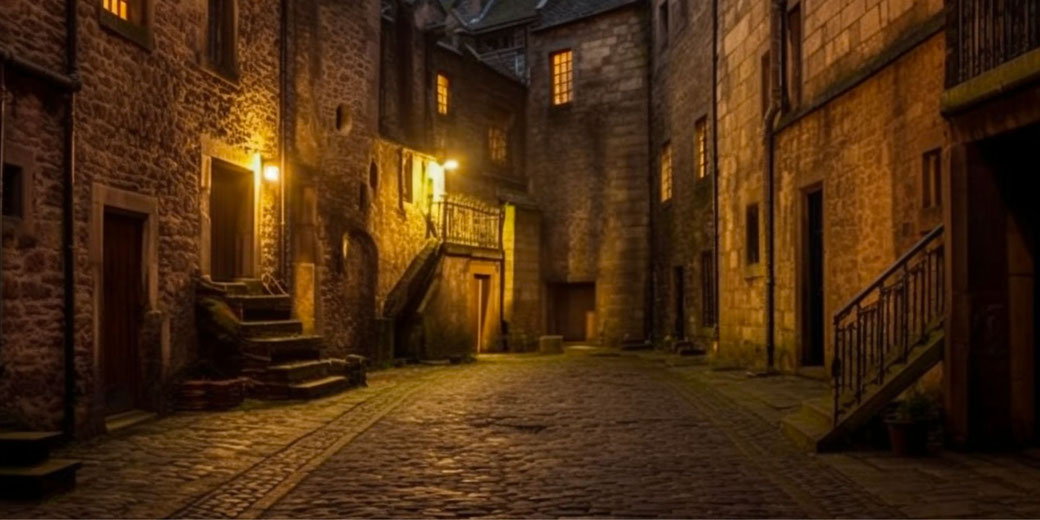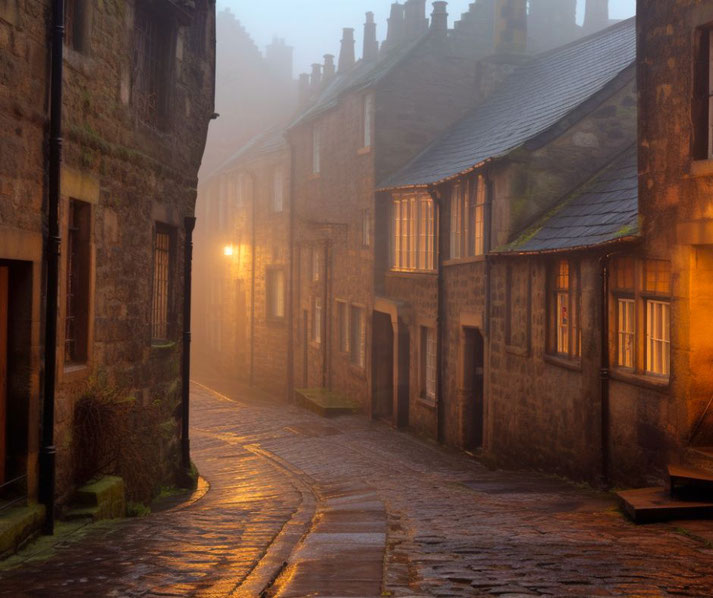The eerily abandoned 17th century streets that still survive, hidden underneath Edinburgh

Beneath the bustling streets of Scotland's capital, Edinburgh, lies a hidden labyrinth of history, frozen in time. This is Mary King's Close, a subterranean warren of 17th-century streets and spaces that whispers tales of plague, poverty, and paranormal encounters.
As you descend into the depths of this underground city, you step back in time, walking the same cobblestones as the merchants, traders, and residents of centuries past.
But what secrets does this buried city hold?
Who was Mary King, and why was this intricate network of alleyways named after her?
What was life like for the inhabitants of the Close during the horrific plague years?
And are the tales of ghostly apparitions and eerie occurrences true, or are they simply the product of centuries of speculation and storytelling?
Welcome to Mary King's Close
Mary King's Close, a narrow alleyway or 'close' as it's known in Scotland, is nestled in the heart of Edinburgh's historic Old Town.
The Close takes its name from one of its most notable residents, Mary King, a merchant burgess who lived there in the 17th century.
Mary King was a woman of considerable standing, a rarity in an era when women seldom held such positions.
Her status was significant enough to have the Close named after her, a testament to her influence and importance.
In the 17th century, the Close was a bustling hub of activity, a microcosm of the city above.
The narrow, winding streets were lined with tall tenement buildings, some reaching up to seven stories high.
These were among the earliest 'high rises', accommodating a growing population within the city's confined space.
The buildings were constructed on a steep incline, which meant that the structures on the higher end of the street were much taller at the front than at the back.
This unique architectural feature, while practical, also added to the charm and intrigue of the Close.
What was it like to live there?
Life in the Close was a blend of commerce and community. The ground floors of the buildings often housed businesses - merchants selling their wares, blacksmiths working at their forges, and taverns serving ale to the weary.
The upper floors, meanwhile, were crammed with residents living in close quarters.
Despite the crowded conditions, there was a strong sense of community among the residents.
They shared the joys and hardships of life, celebrating festivals together and supporting each other during tough times.
However, the Close was not without its challenges. Sanitation was a major issue, with waste often being discarded directly onto the streets.
The lack of sunlight and fresh air, coupled with the close living conditions, made the Close a breeding ground for disease, a problem that would have devastating consequences in the years to come.

The horrifying outbreak of the plague
In 1645, disaster struck Mary King's Close and the city of Edinburgh in the form of the bubonic plague.
This deadly disease, also known as the 'Black Death', ravaged the city, claiming the lives of thousands of its inhabitants.
The Close, with its cramped living conditions and poor sanitation, was particularly hard hit.
The narrow streets and tall buildings that had once been a testament to the city's growth and prosperity now became a death trap, as the disease spread rapidly among the residents.
Contrary to popular myth, the plague victims in Mary King's Close were not walled up and left to die.
While it's true that the sick were often quarantined in their homes, they were not abandoned. Instead, 'plague doctors' would visit the sick, attempting to treat them with the limited medical knowledge of the time.
These doctors, with their beak-like masks filled with herbs to ward off the disease, have become one of the most enduring images of the plague years.
Despite the horrors of the plague, life in the Close continued. The survivors buried their dead and carried on, showing a remarkable resilience in the face of adversity.
However, the Close was forever changed. Many of the businesses that had once thrived there were gone, and the Close began to decline.
Why was it abandoned and buried?
After the plague of 1645, the Close, like many other parts of the Old Town, fell into decline.
Over the following century, it gradually transformed from a bustling hub of commerce and community into a slum.
The once thriving streets were now marked by poverty, and the grand tenement buildings were in a state of disrepair.
In the mid-18th century, Edinburgh was undergoing significant changes. The city was expanding, and there was a desire to modernize and improve living conditions.
The construction of the New Town, on the other side of what is now Princes Street Gardens, was a part of this process.
However, the Old Town, with its narrow streets and overcrowded buildings, posed a challenge.
In 1753, the decision was made to build the Royal Exchange on the site of Mary King's Close.
This was a part of a larger initiative to improve the conditions in the Old Town and create more open spaces.
The Royal Exchange, which is now the City Chambers, was intended to be a symbol of Edinburgh's prosperity and growth.
The construction of the Royal Exchange led to the partial demolition of the Close.
The buildings at the top of the Close were torn down, and the remaining parts were used as the foundation for the new building.
The lower sections of the Close, which were on a steep incline, were left intact but were sealed off.
This effectively buried the Close, preserving it in a state of suspended animation.
The residents of the Close were relocated, and over time, the Close was forgotten. It became a hidden part of the city, a buried relic of the past.
However, the stories and legends of the Close lived on, whispered in the taverns and passed down through generations.
How the lost world was suddenly rediscovered
For nearly two centuries, the Close had been forgotten, buried beneath the city.
However, in the 1930s, the Close was rediscovered during a series of excavations.
This hidden world beneath the city was remarkably well-preserved, offering a unique glimpse into Edinburgh's past.
The rediscovery of the Close sparked a renewed interest in its history.
Archaeologists and historians began to explore the Close, unearthing its secrets and piecing together its past.
They found that the Close was much more than just a network of underground streets.
It was a time capsule, preserving the essence of 17th-century Edinburgh. The homes, businesses, and even some personal belongings of the people who once lived there were still intact, frozen in time.
The rediscovery of Mary King's Close also brought to light the stories and legends that had been associated with it.
Tales of ghostly apparitions and eerie sounds began to circulate, adding to the intrigue of the Close.
These stories, combined with the tangible history of the Close, made it a source of fascination for both locals and visitors.
In 2003, the Close was opened to the public as a historic site. The site is now managed by the Continuum Group, which offers guided tours that take visitors through the preserved streets and rooms.
The guides, dressed in period costumes, share the stories and legends associated with the Close, making it a truly immersive experience.
Ghostly sightings and strange events at the Close
Mary King's Close is steeped in stories of hauntings and ghostly encounters, adding an extra layer of intrigue to its already captivating history.
Visitors and staff members alike have reported eerie experiences and unexplained phenomena within the depths of the Close.
One of the most famous ghost stories associated with Mary King's Close revolves around a spirit known as Annie.
According to legend, Annie was a young girl who fell victim to the plague in the 17th century.
Visitors claim to have sensed her presence, and some have even reported seeing a young girl dressed in period clothing wandering through the Close.
It is said that Annie is particularly drawn to a room within the Close, where visitors have left toys and dolls as a tribute.
Many who have entered this room have reported a sense of unease or a sudden drop in temperature.

Another commonly reported apparition is that of a woman believed to be Mary King herself.
Dressed in 17th-century attire, she has been seen wandering the Close, often appearing unaware of the visitors around her.
Some have even reported feeling a cold touch or a presence in their vicinity while walking through the narrow streets.
The plague years have left their mark on the stories of the Close, with sightings of gaunt figures or the sounds of moans and cries echoing through the chambers.
These apparitions are believed to be the restless spirits of plague victims who met their untimely demise within the Close.
The atmosphere of the Close, with its dark passageways and historic remnants, can create a sense of unease and heighten the feeling of being surrounded by spirits from the past.
Beyond these specific encounters, there have been reports of various other ghostly phenomena throughout the Close.
Visitors have mentioned hearing footsteps when no one else is around, whispers in their ears, or unexplained knocking sounds.
Some have experienced a feeling of being watched or followed, as if unseen eyes were observing their every move.
Whether these ghostly encounters are the result of overactive imaginations, the power of suggestion, or something more supernatural, the tales of hauntings in Mary King's Close continue to captivate visitors.
These stories add an air of mystery and fascination to the historical site, further immersing visitors in the enigmatic atmosphere of the underground city.
What do you need help with?
Download ready-to-use digital learning resources
Copyright © History Skills 2014-2024.
Contact via email
With the exception of links to external sites, some historical sources and extracts from specific publications, all content on this website is copyrighted by History Skills. This content may not be copied, republished or redistributed without written permission from the website creator. Please use the Contact page to obtain relevant permission.





